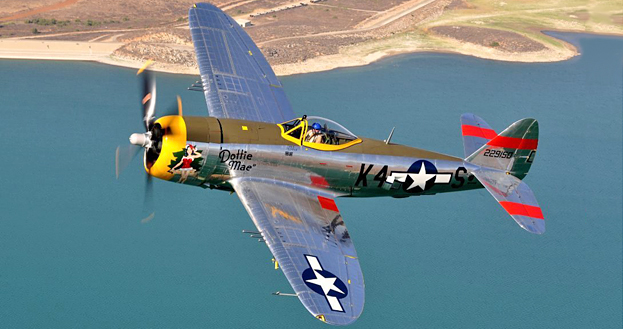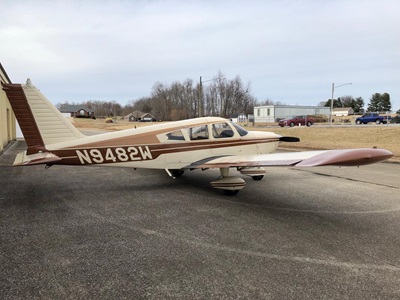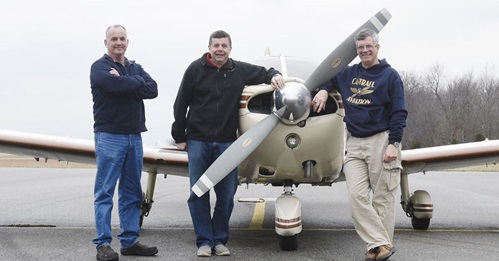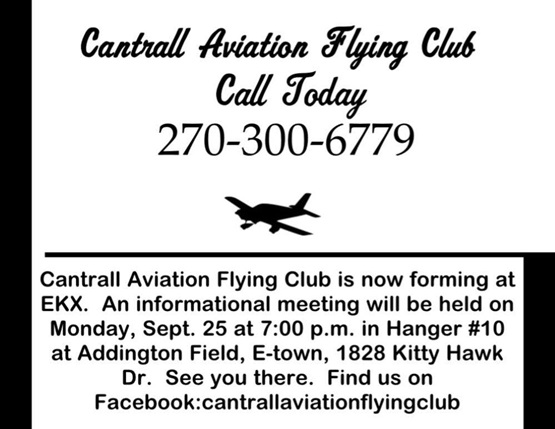When thinking about WWII fighters, most pilots will mention the P-51 Mustang or the Spitfire. Maybe the F-4U Corsair or P-40 Warhawk come to mind, or perhaps the “forked-tail devil” – the P-38, flown by the leading American ace Richard Bong. Often overlooked is the big, powerful P-47.

Similarly, discussions about high-performance general aviation aircraft will usually focus on aircraft like the Cirrus, Bonanza, Cessna 182, and maybe the Piper Arrow. But you’d be hard pressed to find someone who mentions the Cherokee 235. Like the P-47, it’s often overlooked.
That is unless you’re talking to Roy Cantrall. He specifically sought out a Cherokee 235 to form the Cantrall Aviation Flying Club based at Addington Field (EKX) in Elizabethtown, Kentucky. The club’s plane shares more in common with a P-47 besides being a powerful plane that gets overlooked, but we’ll get to that later.
Having a high-powered aircraft in a club environment makes sense if your members are interested in cross-country flying with friends and family. Aircraft with higher horsepower have greater useful load, but the trade-off is usually fuel consumption and purchase price.
The useful load is what makes the Cherokee 235 so attractive. It can haul its own weight, and unlike many other high-performance aircraft, the 235 is affordable to purchase and operate.
The Cherokee 235 was introduced in 1963 to compete with the Cessna 182. In 1973, the fuselage was stretched 5 inches to provide additional leg room for rear seat passengers and the name was changed to the Charger. From 1974 through 1977, it was called the Pathfinder. In 1979, the iconic Cherokee Hershey Bar wing was replaced by the tapered wing and smaller fuel tanks (77 gallons instead of 84 gallons) and the fuselage was stretched another 7.5 inches. The model name was changed to Dakota and that variation remained in production until 1994 (See this month’s Aircraft Spotlight).
Roy learned to fly in a Cherokee 140 and later was in a partnership with three other owners in a 1973 Cherokee 235 with the extra legroom. One day the other owners decided they wanted to get out.
“We sold the one we had, which broke my heart because we had a good one. There I was without an airplane and there was no way I was going to keep flying unless I had people with me,” Roy said. “The club idea came to mind. I pulled some information from AOPA’s website, got two other guys that were interested, we found a 235 and the rest is history.”
Roy used AOPA’s Flying Club Resource Library as “a step-by-step guide. I realized the first thing I needed to do was find somebody who wanted to be involved with it, which was a struggle because I had no airplane.”
Flying Club Initiative Director Steve Bateman held a Maximum Fun, Minimum Cost seminar on starting a flying club at EKX that Roy hosted and about a dozen people attended.
Roy then went to the airport board to talk about the idea of starting a club. That’s where he met Don, a board member and former pilot for Southwest Airlines, who was interested. Roy is a retired teacher, and one of his former students, Jason, was in the process of selling his Cessna Cardinal. When he learned about the club, he expressed his interest in joining, too.
Neither Don nor Jason had flown a 235, but “it wasn’t difficult to sell them on the type of aircraft,” Roy said. “They climb like homesick angels compared to the 140, it’s a very stable platform to fly, and it is a true cross country [aircraft].” With its ability to carry four adults and a full fuel load of 84 gallons, Roy refers to the 235 “as the station wagon of the Cherokee line.”
It’s not the fastest plane out there, with a cruise of 125 knots, and it’s not the most fuel efficient, burning about 12 to 13 gph, but it can fly on auto fuel. “The equalizing factor is we run mogas in ours. You can run regular 87 octane fuel through that thing and instead of paying $4 to $5 a gallon [for avgas], we’re paying $2.80 a gallon.”
The plane has four fuel tanks – a 25-gallon tank in each wing and a 17-gallon wing tip tank on each side. The tip tanks are made of fiberglass, so you can’t use mogas in those tanks or the gas will eat it away. The club keeps about 10-gallons of avgas in each tip tank. Mixing avgas and mogas is not a problem. 
The core group began looking for an airplane while working on the paperwork to establish the club. Roy utilized the sample documents from AOPA’s Resource Library to draft the club’s bylaws.
Finding a good 235 can be a bit difficult. Eventually they found a 1968 Cherokee 235 in western Kentucky. But it hadn’t been flown for a while. There was dust on the wings, a flat tire, and the panel needed work. But the price was right -- $40,000.
So they bought the plane knowing they needed to spend some time and money making improvements. They started by putting shoulder harnesses in the front seats, replaced the audio panel and transponder, repaired a radio, and installed electronic ignition. They’ve also replaced three cylinders since they’ve had the plane. “The worst thing you can do is let those things sit and that’s what happened,” Roy said.
When the plane goes in for its annual this month, the club will install two G5s and a Garmin 175 GPS, along with a dual axis autopilot. “We’ll have a really nice airplane when it all said and done,” Roy said. With the installation of the G5s, the vacuum system will be removed, saving a little weight.
Finding Members
Attracting members also took a little time. The club used a mix of traditional and tech savvy methods of getting the word out. They created a Facebook page and had two articles written about the club in the local paper. One came out while they were in the process of forming and looking for a plane, and the second article ran after they bought the 235 and became operational.
They also distributed large 18x24 inch posters and business cards to local airports. At least one member saw the poster at Bowling Green-Warren County Regional Airport (BWG) and joined the club.
The FBO at Addington also has been helpful. “I know they have referred several people to me who were interested in joining a flying club,” Roy said.
The Cantrall Aviation Flying Club doesn’t take student pilots, so there is no competition with the flight school. The club does allow members to work on advanced ratings and one is working toward an IFR rating.
Since the club became operational in January 2018, it has grown from the three founding members to its cap of 11 members. The club mission is “to provide member pilots a quality aircraft to enjoy affordable recreational flying and camaraderie.”
Each share is $5,000 and there is a non-refundable $1,500 subscription fee new members pay when they join. When a member leaves, the new member would buy the share from the outgoing member and pay the club the subscription fee. Dues are $85 a month and the hourly rate is $48, tach time dry.
Most members generally fill up five-gallon jugs at a local gas station that sells fuel without ethanol and bring it to the airport. Unfortunately, there isn’t a mogas pump on the field.
Several of the members use the plane for longer cross-country flights – a mission the plane is well suited for. One member visits his son in South Bend, Indiana and Roy has flown to Mississippi to visit friends. “Another guy likes to fly down to Missouri. There’s a restaurant there he likes to go to and he’s been down there several times,” Roy said. “We do a lot of cross countries.”
Roy and another member also use the club plane to fly animal rescue missions. They have done several Pilots ‘n Paws missions and fly for a group called Bassett Rescue of Kentuckiana that rescues dogs in Kentucky and Southern Indiana. Those flights tend to be a little more local, but with the plane’s high useful load, there’s never any worry about weight and balance.
Despite the pandemic, the club has built camaraderie by doing maintenance on the plane together. Roy has mentored the other members by showing them how to change the oil, which saves the club about $100 each oil change. In addition, they do owner-assisted annuals with several members helping out. Roy said it’s a great way to learn about the airplane and just have a good time with each other.
Dottie Mae
So what does the Cantrall Aviation Flying Club’s Cherokee 235 have in common with a P-47? The club named their plane, Dottie Mae, and it has a double meaning for Roy.
“I’m a WWII buff and my favorite aircraft out of WWII is the P-47. There was a P-47 that was pulled out of a lake in Austria and its name was Dottie Mae,” Roy said.
That airplane flew 90 combat missions and became the last American fighter that was lost in combat in the European Theater on May 8, 1945. The pilot was doing a low flyby over the lake to raise the morale of prisoners held in a concentration camp that was being liberated.
The tips of the 13-foot-diameter propellor caught the water and the plane went down. Fortunately, the pilot survived before the plane sank. Sixty years after the crash, it was recovered in 2005 and restored to flying condition. Today, it is owned and flown by Allied Fighters in Chino, California.
But nostalgia wasn’t the only reason for naming the club’s plane. “Dottie Mae was also my mother’s name,” Roy said. “I asked the guys if they minded if I named the plane Dottie Mae and they said no. I had a little decal made up and that’s what we call her, Dottie Mae.”
Like its historic namesake, the Cantrall Aviation Flying Club’s Cherokee 235 has a powerful engine, can carry a large load with good range – and sometimes gets overlooked.
Factsheet
|
Name |
Cantrall Aviation Flying Club |
|
Location |
Addington Field (EKX) Elizabethtown, KY |
|
Website |
None |
|
|
|
|
Year formed |
2018 |
|
Aircraft |
1968 Piper Cherokee PA28-235 ($48/hr) Rates are Tach time, dry. |
|
Joining fee |
$5,000 buy-in plus $1,500 non-refundable subscription fee |
|
Monthly dues |
$85 per month |
|
Membership |
11 (capped at 11) |
|
Scheduler |
Bookourplane.com |